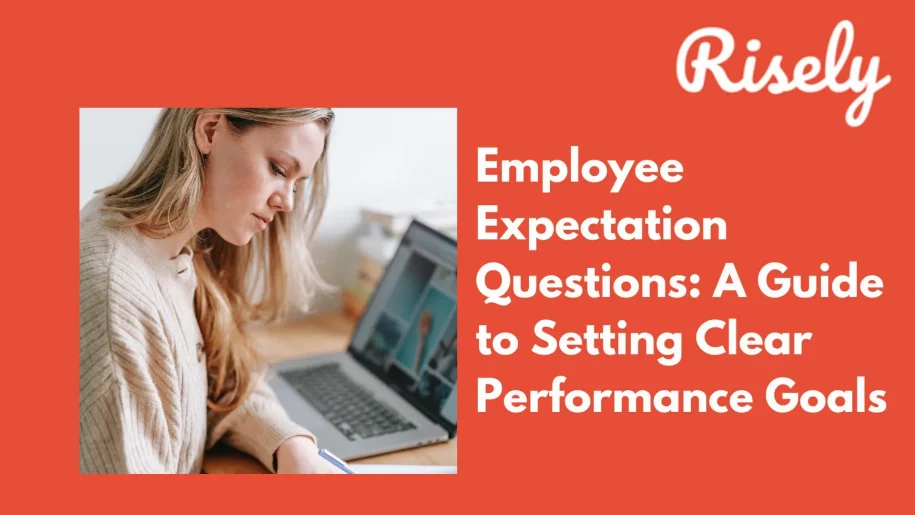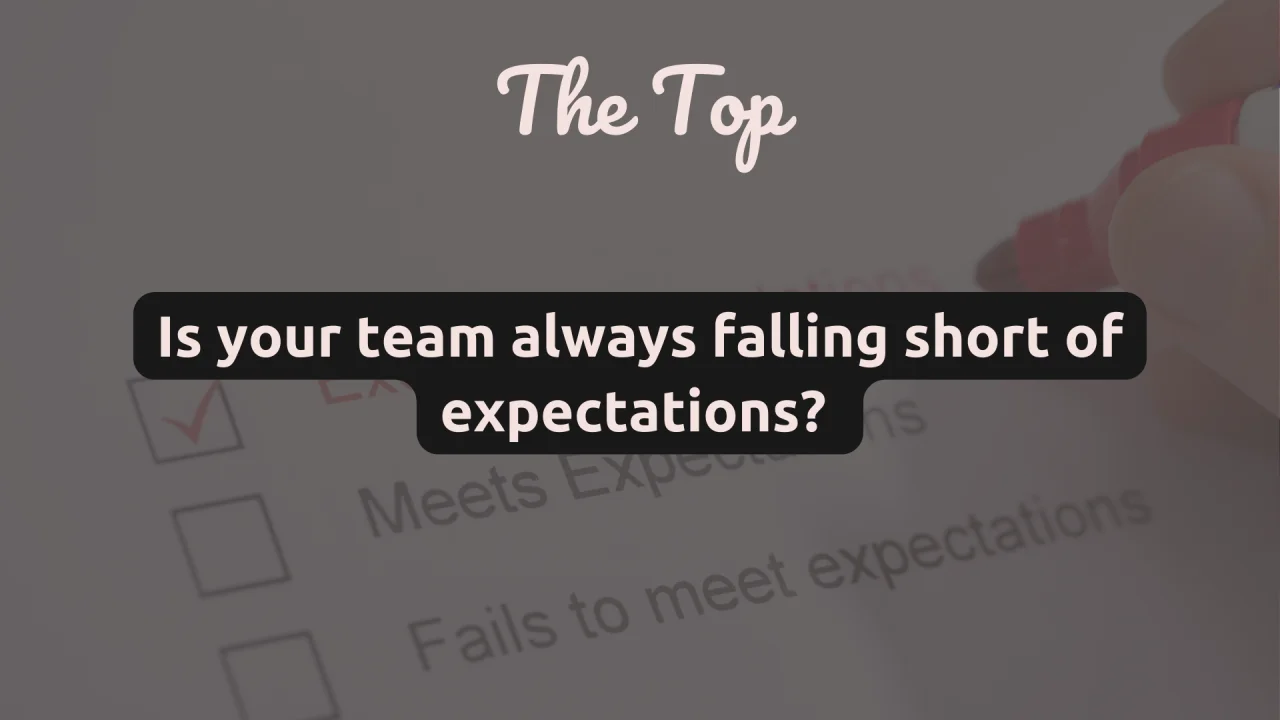Employee Expectation Questions: A Guide to Setting Clear Performance Goals
As an employer or manager, setting clear and realistic expectations is essential for creating a productive and positive work environment. But what exactly are employee expectations, and why are they so important? Employee expectations are the specific goals, targets, and objectives employers or managers set for their employees. In this blog, we’ll explore the importance of setting clear employee expectations, the different types of expectations that exist, and answer important questions about expectations. So whether you’re a new manager looking to set expectations for your team or an employee looking to understand your role and responsibilities better, this blog has something for everyone.What are employee expectations?
Employee expectations refer to the desired outcomes or results an employee is expected to achieve. These expectations are typically set by the employer or manager and are based on the job description, company goals, and the individual’s skills and abilities. In addition, employee expectations may include specific job responsibilities, performance standards, key performance indicators (KPIs), deadlines, and targets. Setting clear employee expectations is important because it helps employees understand what is expected and provides a framework for evaluating their performance. Clear expectations also help managers provide feedback, support, and guidance to employees, which can improve their job satisfaction, engagement, and overall performance. Clear expectations can also reduce misunderstandings, conflicts, and employee turnover.Different types of employee expectations?
There are several different types of employee expectations that managers may set for their employees, including:- Job-related expectations outline the responsibilities and duties an employee is expected to perform, such as completing specific tasks, meeting deadlines, and maintaining quality standards.
- Performance expectations focus on the results that an employee is expected to achieve, such as meeting or exceeding sales targets, improving customer satisfaction ratings, or reducing error rates.
- Behavioral expectations relate to how an employee is expected to behave or interact with colleagues, customers, and stakeholders, such as demonstrating professionalism, respecting diversity and inclusivity, or following company policies and procedures.
- Development expectations outline the opportunities and support employees can receive for their professional growth and development, such as training, mentoring, or career advancement.
- Cultural expectations relate to a team’s values, beliefs, and norms, such as teamwork, innovation, or a customer-first mindset.
How to set employee expectations?
Here are some steps you can follow to set clear employee expectations:- Start with job descriptions: Ensure each employee has a clear and accurate job description outlining their roles, responsibilities, and expectations.
- Identify performance indicators: Determine the key performance indicators (KPIs) or metrics that will be used to evaluate employee performance, such as sales targets, customer satisfaction ratings, or project completion rates.
- Set specific goals: Work with each employee to set goals that are specific, measurable, attainable, relevant, and time-bound (SMART) goals that align with the overall objectives of the organization.
- Provide feedback: Provide regular feedback on employee performance, progress towards goals, and areas that need improvement.
- Encourage questions: Encourage employees to ask questions and seek clarification on any expectations that they may not understand.
- Involve employees in setting expectations: Involve them in setting expectations to ensure that they feel ownership over their goals and are more likely to be motivated to achieve them.
- Provide ongoing support and training: Provide ongoing support, coaching, and training to help employees meet expectations, develop new skills, and grow professionally.
- Review and revise expectations regularly: Review employee expectations regularly and revise them as needed to ensure they remain relevant, achievable, and aligned with the team’s needs.
Other Interesting Reads
Examples of employee expectations
Job-related expectations- Completing assigned tasks on time and to a high standard
- Responding to customer inquiries promptly and professionally
- Maintaining accurate and up-to-date records and documentation
- Meeting or exceeding the set targets
- Achieving a high level of customer satisfaction ratings
- Achieving high productivity levels and efficiency metrics
- Demonstrating a positive attitude and strong work ethic
- Communicating effectively with colleagues and stakeholders
- Maintaining confidentiality and respecting sensitive information
- Participating in training and development programs for teams to improve skills and knowledge
- Seeking feedback and guidance from colleagues and superiors to improve performance
- Sharing knowledge and expertise with colleagues to promote learning and development
- Embracing a customer-first mindset and focusing on delivering value to customers
- Embracing innovation and creativity to improve processes and products
- Demonstrating a commitment to the organization’s values and mission.

5 employee expectation questions
What do you need to be successful in your role?
This employee expectation question helps identify the resources, support, and tools employees need to perform their job responsibilities effectively and efficiently. By asking this question, managers can gain insights into how to provide the necessary resources, support, and training to help employees achieve their goals and succeed in their roles. This question also allows employees to voice their concerns and provide feedback on the work environment, workload, and other factors affecting their performance. Overall, asking this employee expectation question demonstrates a commitment to supporting employees and shows that the manager is invested in their success. It can also help build trust and positive relationships between managers and employees, benefiting the team.How do you prefer to receive feedback?
This employee expectation question helps to identify the most effective way to communicate feedback to employees so that it can be received and acted upon constructively and productively. Everyone has a different preference for receiving feedback, and some employees may prefer feedback delivered in person, while others may prefer written feedback. In addition, some employees may prefer feedback immediately, while others may like to receive it later. By asking this employee expectation question, managers can identify the most effective way to communicate feedback to each employee, leading to improved performance, increased motivation, and greater job satisfaction. In addition, asking employees how they prefer to receive feedback demonstrates a commitment to their personal and professional development and shows that the manager values their input and feedback. This can help build trust and positive relationships between employees, benefiting the organization. Overall, by understanding and respecting the preferred feedback style of each employee, managers can create a supportive work environment where feedback is received and acted upon constructively and productively.What motivates you in your work?
This employee expectation question helps to identify what drives employees to perform their job responsibilities effectively and what factors contribute to their job satisfaction. By understanding what motivates employees, managers can tailor their management approach to meet the needs of each employee. For example, if an employee is motivated by recognition and rewards, managers may recognize their achievements publicly or offer incentives for achieving specific goals. If an employee is motivated by a sense of purpose and mission, managers may focus on communicating the organization’s vision and values to help the employee feel connected to the organization’s mission. By asking this employee expectation question, managers can also demonstrate a genuine interest in their employee’s well-being and job satisfaction. Understanding what motivates employees can help managers create a supportive work environment where employees feel valued and empowered to perform their best.What challenges do you foresee in achieving your goals?
This employee expectation question helps to identify potential obstacles or roadblocks that may prevent employees from achieving their goals. By understanding the challenges that employees foresee, managers can take proactive steps to help employees overcome these challenges. For example, if an employee anticipates that they may struggle to meet a deadline, a manager can provide additional resources or support to help them complete their work on time. In addition, asking this employee expectation question can foster open and honest communication between managers and employees. It demonstrates that managers are invested in their employees’ success and willing to listen to their concerns and help them navigate potential challenges. Bonus: How To Know Your Team Better? 10+ Questions For ManagersWhat goals do you have for yourself in the next 6 months?
This employee expectation question helps identify the specific goals and objectives that employees have set for themselves, which can be used to align individual goals with the organization’s overall objectives. By understanding the goals that employees have set for themselves, managers can provide the necessary support, resources, and guidance to help employees achieve their objectives. This can include providing feedback, coaching, mentoring, and identifying training and development opportunities to help employees build the skills and knowledge they need to succeed. In addition, asking this employee expectation question can help to create a culture of accountability and ownership. It demonstrates to employees that they are responsible for their professional growth and development and that their contributions are valued and recognized. It can also align individual goals with the team’s overall objectives, benefiting the team. In addition, managers can help employees achieve their goals and contribute to the team’s success by providing support and guidance. Adopt collaborative goal-setting with your team move forward together: Collaborative goal-setting: How to achieve team success?Conclusion
In conclusion, finding meaning and motivation in your job is important to achieving professional and personal fulfillment. By setting clear goals and expectations, identifying your strengths and weaknesses, and finding ways to connect with your work on a deeper level, you can transform your job into a more satisfying and rewarding experience. Remember, it’s essential to take ownership of your career and actively seek opportunities for growth and development. Whether taking on new challenges, seeking mentorship and coaching, or pursuing additional education and training, investing in yourself and your career has many ways. We hope this blog has provided practical strategies and tips for finding more significant meaning and motivation in your job. Putting these ideas into practice can unlock your full potential and achieve greater professional and personal fulfillment. So take that first step towards a more meaningful and rewarding work experience.Strengthen your communication skills to build healthier workplaces.
Get your communication skills assessed now to understand hidden mistakes that hold you back.
Frequently asked questions
What are your top 3 expectations from a company?
– Fair compensation and benefits
– Opportunities for growth and development
– A positive and respectful work environment
– Opportunities for growth and development
– A positive and respectful work environment
What are employees’ expectations?
Some common employee expectations are:
– Fair compensation and benefits
– Opportunities for growth and development
– A positive work environment
– Clear expectations and feedback
– Work-life balance
– Fair compensation and benefits
– Opportunities for growth and development
– A positive work environment
– Clear expectations and feedback
– Work-life balance
What are your expectations at work?
– Clear communication
– Opportunities for growth and development
– Fair treatment
– A positive work environment
– Trust and autonomy
– Opportunities for growth and development
– Fair treatment
– A positive work environment
– Trust and autonomy
How do you tell your team your expectations?
To effectively communicate your expectations to your team, you can follow these steps:
– Clearly define your expectations
– Explain why the expectations are important
– Encourage feedback
– Follow up
– Clearly define your expectations
– Explain why the expectations are important
– Encourage feedback
– Follow up
Other Related Blogs
Is your team always falling short of expectations?
Is your team always falling short of expectations? Hey there, manager! If you’ve been here for a while, you’d know that expectation setting is one of the core areas a…
7 Gen Z Workplace Expectations From A Manager
7 Gen Z Workplace Expectations From A Manager More and more members of Generation Z (Gen Z) are entering the workforce every year, and they are already challenging traditional workplace…
5 Great Expectation Setting Tricks Every Manager Needs
5 Great Expectation Setting Tricks Every Manager Needs As a leader, setting expectations at work is crucial to ensure that your team is aligned toward achieving common goals. But with…
5 Creative Expectation Setting Activity For All Managers
5 Creative Expectation Setting Activity For All Managers As a manager, it’s essential to set clear expectations with your team to ensure everyone is on the same page and working…


